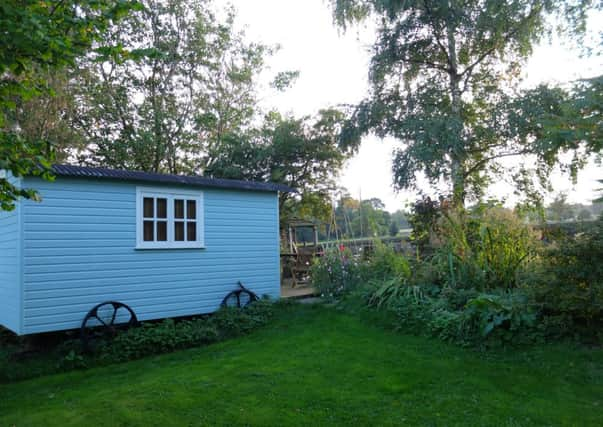Primitive huts now a trendy luxury


It’s the ultimate hideaway that combines rustic charm with a multitude of uses, from office to holiday home.
Pennie and Kevin Lordan, of the Yorkshire Hut Company in Nether Poppleton, York, specialise in building them from FSC timber, with cast iron wheels, windows fitted with energy-efficient glass and sheep’s wool insulation.
Advertisement
Hide AdAdvertisement
Hide AdPrices start from £10,000 and the beautifully crafted havens are a far cry from their predecessors. In his book ‘Shepherds’ Huts and Living Vans’, author David Morris reveals how basic the originals were. Early 19th century huts were draughty and dirty, made as cheaply as possible by the village blacksmith or fashioned from an old chicken shed. The bed was a hessian sack stuffed with straw. With no washing, cooking or heating facilities, the shepherd survived on bread and cheese, a raw onion, a keg of cider or a bottle of cold tea.
His wardrobe consisted of grimy, old overcoats leather aprons and hats hung on pegs so he could rotate them as they became too wet to wear.
Life improved when huts were made commercially. The floor was raised clear of damp ground, some had corrugated iron cladding, though few had windows, just a stable door that kept the dog out and allowed ventilation and a view over the pasture. They were also fitted with a timber lining and a small cast iron stove, allowing the shepherd to cook and boil water.
“Tending sheep is a messy business. Scraping maggots or larvae out of scabs and infections, handling greasy wool and clipping manure tangled wool from sheep’s behinds are just some of the daily tasks a shepherd had to perform. A pan of hot water would have been a welcome enhancement,” says David.
Advertisement
Hide AdAdvertisement
Hide AdHuts, which were moved by horses, gradually became larger and from the 1920s they were pulled by tractors. Rudimentary wooden platforms acted as beds, while the space underneath was used as a gated crèche for sickly lambs.
Another important feature was the medicine cabinet. The most skilled shepherds owned a trocar, or letting spike. This tool could save the life of a sheep whose stomach had become bloated from eating too much rich grass or root vegetables. The spike would be inserted into the sheep’s abdomen to release gas.
Other jobs included dipping, repairing hedges and fences, cutting root crop into bite-size feed and marking sheep with tallow, grease and dye. Folding sheep, creating pens using hazel hurdles, was among the most tiring jobs. Each hurdle weighed 20lbs and had to be regularly uprooted and moved.
The meticulously researched book reveals how shepherds were at the top of the pay scale among farm labourers. Wealthy estate farms would often reward their best men with a deluxe hut with windows, says David, a conservation engineer who was inspired to put pen to paper after rescuing old huts.
Advertisement
Hide AdAdvertisement
Hide Ad“I’ve always found shepherds’ huts fun and I have a lifelong interest in farming and rural history. My wife and I rescued two huts about ten years ago before the recent trend for owning a hut had really begun. We sensitively restored them, keeping as much of the original as possible, and use them in our garden as a fun place for a cup of tea or glass of wine after gardening, and to store fruit and veg in. Then like all things, I guess you start to get more interested, collect photographs, anecdotes, notes, and all kinds of hut stuff.”
His research uncovered many misnomers. “Anything with a curved tin roof and a wheel on each corner was being called a shepherds’ hut,” says David, who distinguishes between road roller vans, ploughing vans, and threshing vans, which were built differently. The advert for the Crosskills Road roller van made in East Yorkshire is a good case in point. It shows how easy it can be to mistake a workers van for a shepherds’ hut.”
The real thing was most prevalent in Southern England and France. Dorset was a hot spot and there’s evidence of them being used in Yorkshire, though they were not prevalent thanks to the terrain.
David says there’s a chance of finding some form of wheeled hut anywhere in the world but it depends on a number of factors, such as geography, climate and cost.
Shepherds’ Huts and Living Vans by David Morris is published by Amberley, £16.99, www.amberley-books.com